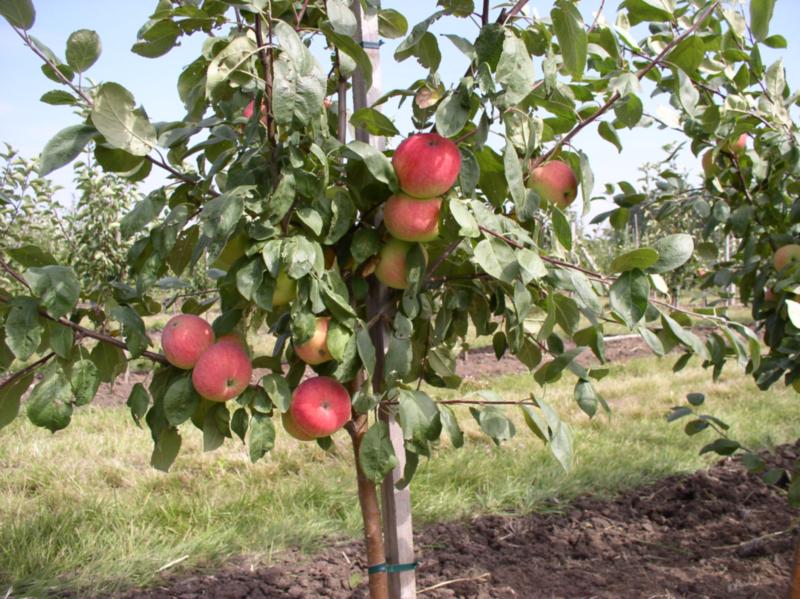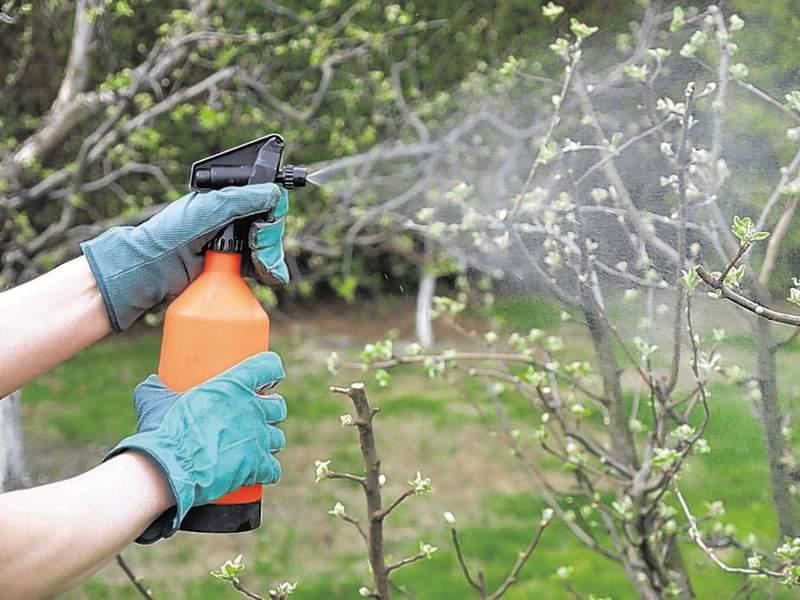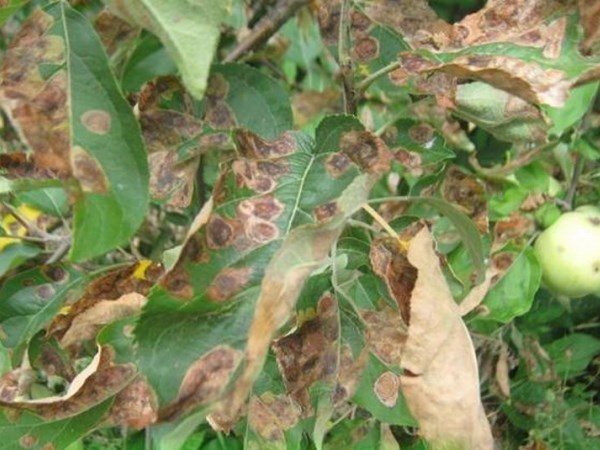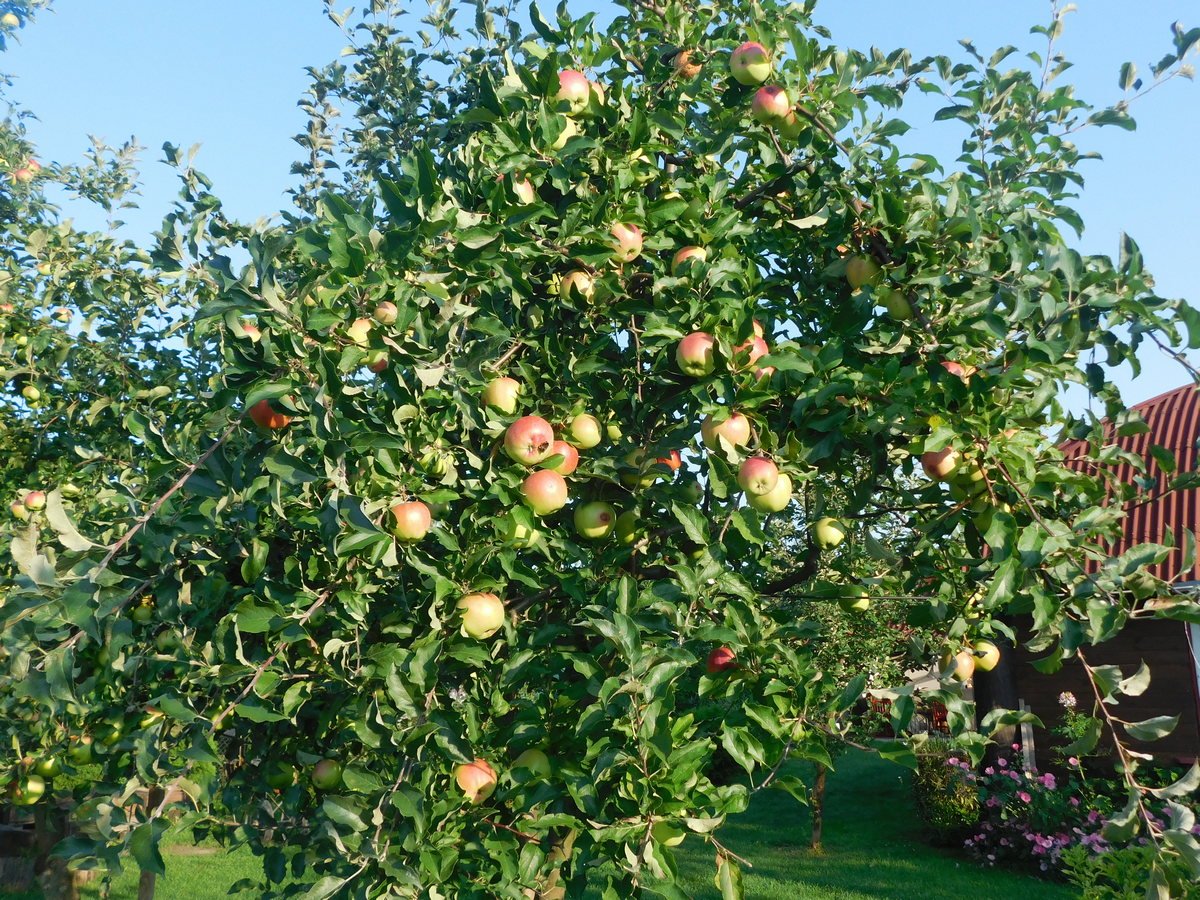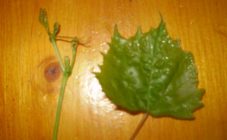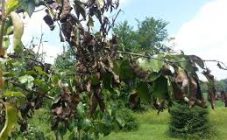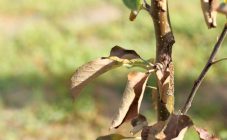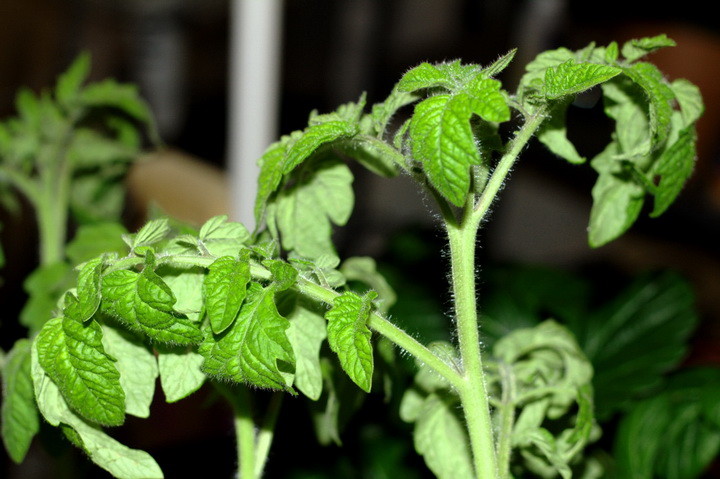Content:
Like most other fruit trees, the apple tree is negatively affected by certain viruses, fungi and bacteria. In addition, some pests can harm the tree. Therefore, it is appropriate to consider the question of how to treat an apple tree and prevent various diseases.
Apple tree care
It is not difficult to identify disease or pests if you inspect the trees of your garden in a timely manner. This should be done several times a year. Particular attention should be paid to the bark, branches and leaves of the apple tree. On sale today you can find universal chemicals that help get rid of many varieties of microorganisms and fungi at once. However, the treatment of individual diseases requires special control methods.
How to treat an apple tree
Scab
This is a fungal disease. As a rule, it develops in situations where the tree suffers from air stagnation in the crown and excessive moisture. First of all, the leaves of the tree are damaged: a large number of brown spots appear on their inner side. Over time, each apple begins to be covered with the same.
Ways to fight:
- As soon as spring comes, sprinkle the entire tree (together with the crown) with a urea solution from a spray bottle. A bucket of water will need about 0.5 kg of active ingredient.
- Twice in early spring (before flowering), sprinkle the tree with copper chloride. You need to dilute the product in a ratio of 40 g per bucket of water.
- You can also treat apple scab with Bordeaux liquid. To prepare the product, you need to mix lime (300 g), water (10-11 l), copper sulfate (300 g).
Powdery mildew
Fungal disease primarily affecting new branches, leaves and inflorescences. A young apple tree first becomes covered with a white bloom, over time its leaves darken, curl upward like boats, and fall off.
Ways to fight:
- Spraying the tree with 70% colloidal sulfur solution.
- Treatment with Skor or Topaz preparations.
Bacterial burn
Most often, this quarantine disease develops in the middle of summer. First of all, young trees and seedlings yield to it. Blackening and drying out of the leaves are the main symptoms.
The only way to fight is to completely destroy the sources of the disease: damaged branches or the entire tree. The cut site must be treated with a solution of copper sulfate (1%).
Cytosporosis
A fungal disease that affects only certain areas of the tree bark. At first, the gardener notices small dark spots on the tree, but gradually they turn into ulcers, penetrating deeper and deeper. If nothing is done, the tree will be completely destroyed.
The main ways to fight the disease:
- Treatment in early spring of the tree with the preparation "Hom".
- Before flowering, spraying the trunk and crown with a solution of copper sulfate (dissolves in a proportion of 50-55 g per 10-11 liters of water).
- On the eve of frost, potash and phosphorus fertilizers need to be applied, as well as whitewashed trees.
In addition to the above, apple trees can also be infected with many other plant diseases, in particular, fruit rot, black cancer, milky shine and others.
Pest control
Among the large number of pests of fruit trees, it is worth highlighting the 4 most dangerous for the apple tree:
- Apple blossom beetle. Attacks a tree during flowering. With its long trunk, it gnaws out the middle of the buds and buds, and lays eggs inside. Therefore, you should not hope for the appearance of fruits. The leaves will fall in advance.
The fight against parasites is reduced to shaking them from the tree and processing the tree with dichlorvos.
- Apple sawfly. The caterpillar penetrates into the heart of the green unripe fruit and eats away the seeds. Therefore, the apple has no chance of ripening and falls off.
It will be possible to fight the pest using the following methods:
- from live caterpillars, the apple tree is sprayed with chlorophos or karbofos even before the tree blooms;
- with the same drugs, you need to re-process the tree after harvesting, because this way you can destroy the larvae themselves.
- Apple moth. This caterpillar-butterfly eats the fruits of the apple tree: it gnaws through them, sucking everything useful also from the seeds. As a result, damaged apples fall off.
Having found such parasites in his garden, the gardener will have to follow these steps:
- in early spring, tear off the bark from the infected tree and burn it;
- after the apple tree has faded, it will be necessary to treat it with a solution of: water (10-11 l), arsenic acid potassium (25-30 g), lime (35-40 g);
- at the end of July, wrap the tree with special adhesive belts for catching caterpillars.
- Apple scale insect. These are very small and not always visible insects, which, however, are capable of destroying a young and strong tree. Actively multiplying, they try to suck all the juices from the apple tree. Consequently, she becomes vulnerable to all diseases, weak.
Help in different cases
If leaves curl
One of the most frequent questions of newbie gardeners on thematic forums is this: "leaves are spinning on an apple tree, what should I do?" To begin with, as the experienced owners advise in this matter, you need to find out the reason for this situation, because a leaf can curl both through illness, and through parasites or weather conditions.
Thinking about why the leaves of the apple tree curl, the first thing to check is whether the apple tree is infected with aphids. It is a small insect that reproduces very quickly. Already after 14 days from the moment of birth, the aphid is capable of laying eggs (80-100 pieces at a time). If you do not start a timely fight against the parasite, then in a few weeks the entire garden may be infected. Meanwhile, finding this parasite is not difficult: you need to carefully unfold the folded sheet. Most likely, there will be an aphid body inside. The affected leaf will feel sticky to the touch. Curling is only the first stage, over time, damaged leaves will dry out.
It is worth treating an infected tree with insecticides only in difficult cases when other methods have not yielded the desired result. The chemical components of such drugs can harm the apple tree itself (especially if it is still young) and people too. Therefore, the first measure in the fight against aphids should be a solution of soap and kerosene. An alternative option is a hot pepper soap solution. Each branch should be generously sprayed with such means. Some owners propose to make a large fire next to the tree and throw tobacco leaves there. This pungent smoke will kill insects.
If it was not possible to identify aphids, and the leaves of the apple tree curl, what to do? Look for the real reason.The problem may be associated with powdery mildew. This is a fungal disease that primarily affects the leaves and shoots of young trees.
Curly hair is not the only symptom of the disease. The appearance of the leaf changes: at first it becomes pale, then dark brown spots appear on it. It is easy to overcome powdery mildew at an early stage, but when neglected, the leaves of the apple tree begin to dry and fall off. The damaged leaves will have to be torn off and burned. It is better to treat the apple tree itself with the Topaz fungicide.
Another reason why the leaf can curl up and become like a tube is the lack of certain minerals. So, with a lack of potassium, the leaf can turn pale and curl down. This often happens if the apple tree grows on acidic soils, or when the owner has added too much potassium permanganate to the soil. The problem can be solved if the tree is fertilized with ash, potassium chloride or manure.
On the contrary, the apple leaf twists upward if it is low in calcium. In this case, you can observe the dying off of the growth point, as well as intensive shedding of all leaves. It will be possible to stop the negative process if the tree is fertilized with sulfuric acid calcium.
Excessive heat and lack of moisture can curl the leaves of a young apple tree. At least 1-2 buckets of clean water under the root within one week will solve this problem.
Apple leaves brown
There are several reasons why brown spots appear on the leaves of an apple tree:
- Scab. Typically, this fungal disease affects fruit trees in summer. The disease progresses very quickly, so after a few weeks nothing remains of the pleasant green leaf of the apple tree: it becomes covered with brown painful spots, sometimes with an olive tint. Dew, moderate rainfall and fog encourage the growth of the fungus. If the treatment was not started in a timely manner, then the leaves begin to blacken and fall off.
- Medianitsa (or in other words listobloshka). This insect is very fond of young green shoots and leaves. A tree infected with a parasite can be recognized if the flowers on the apple tree turn brown. Sometimes the dark spots on the leaves stick out noticeably.
The fumigation method and a special solution - karbofos help to cope with the pest.
- Lack of potassium. This microelement is most needed by a young seedling during the growth of the first spring shoots. If its deficiency is critical, the leaves on the apple tree turn brown and dry out. To avoid a deficiency of this element, which means that it will be possible to darken the leaves if we carry out timely seasonal feeding with wood ash or sulfuric acid potassium.
- Low temperature conditions. In this case, the leaves do not completely change their color, only along the edges. The owner does not have to carry out special measures. With the arrival of warm days, the crown regains its usual color.
- Sandy soil. The edge of the leaf may also darken if the tree is planted on sandy soil. The lack of all minerals and moisture causes such consequences.
Phylostictosis treatment
The brown color of round or angular spots on the leaves indicates a disease such as phyllostictosis, or brown spotting. The disease is of fungal origin and affects apple and pear trees to the greatest extent. If you look closely, you can see small black dots on the leaf. Often, such damage to the tree is perceived as chemical burns after treating the tree with pesticides.
You can get rid of the disease if the tree is treated with fungicides during the growing season. All leaves damaged by the disease must be manually plucked and burned.
The appearance of pink leaves
Experienced gardeners name at least 3 main reasons due to which the leaves get a pinkish or deep red color:
- Lack of trace elements. The leaves can turn red if the soil lacks, in particular, the following elements:
- phosphorus - a deficiency of a trace element leads to the fact that the flowering and ripening of apples occurs later than expected, winter hardiness decreases significantly, pink spots appear near the veins and petioles;
- manganese - the lack of an element makes the leaves pale, red or light green, but the veins remain green for a long time; the yield is significantly reduced;
- magnesium - only the lower leaves of the tree become purple or reddish with a lack of a trace element, early in the autumn the tree sheds its leaves and has practically no chances to successfully survive the frosty winter.
- Defeat with red-gall aphids. This parasite harms currant bushes most of all, but chooses fruit trees for its base. First, the juicy young shoots and leaves succumb to the negative influence of the parasite. Having sucked out all the useful from them, the aphid moves to another area. The owner does not always manage to notice the pest in a timely manner, because his colonies usually hide on the inside of the leaf. After the aphids use the leaves, they develop large, swollen, pink patches. Sometimes these begin to curl.
- Mechanical damage. Wire, cord, film, which cut into separate branches of the tree, can significantly harm the apple tree. From such damage, the leaves begin to turn red and wither.
Preventive measures
Given the large number of diseases and pests that can harm the apple tree and its crop, gardeners give their advice on preventive measures:
- Every spring, as well as in late autumn, whitewash the stamps of the tree with limestone milk. To prepare this, you should adhere to the following proportions: 10 liters of water, 2-2.2 kg of lime, 450-550 grams of five percent copper sulfate.
- If trees grow closely in the garden or have wide crowns, in spring they should be treated with a 2% solution of milk of lime. Spraying of trees takes place using the hose method.
- Ensuring adequate moisture levels, especially during hot and dry periods.
- Tracking soil acidity. If the level exceeds the norm for the variety, it is worth "extinguishing" the acid with a lime solution in the area of the trunk.
- Regular feeding with phosphorus and potassium fertilizers at the rates recommended by the manufacturer.
- Timely fight against diseases and parasites using folk methods or fungicides, antiseptics.
- Spring and winter pruning.
A novice gardener should know that even if he adheres to all the recommended preventive measures, his apple trees can still get sick, because there are many factors that the owner cannot prevent. That is why regular inspection of trees is a must for every apple orchard owner.
